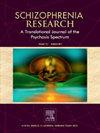临床高危精神病的早期和后期缓解。潜类和预测因子分析
IF 3.6
2区 医学
Q1 PSYCHIATRY
引用次数: 0
摘要
背景在高危精神病患者(CHR-P)中,很多人都把注意力集中在向精神病的过渡上。然而,理想的结果仍然是尽早缓解症状和改善功能。本研究旨在调查症状缓解和功能改善亚组的预测因素。材料和方法:本研究采用系统的早期检测策略,对在挪威招募的104名CHR-P参与者进行了为期两年的前瞻性随访研究。采用前驱综合征结构访谈(SIPS)评估CHR-P。根据症状评分将参与者分为缓解和未缓解两类。对二分法数据进行潜类分析,以确定缓解时间的潜类。采用 t 检验和卡方检验来评估类别归属、预测因素和结果之间的关联:"缓解机会差"(16.7%)、"缓解较晚"(34.3%)和 "缓解较早"(49.0%)。与 "晚期缓解 "分级相比,"早期缓解 "分级的快速和稳定缓解概率最高,病前学习成绩、基线和 2 年的整体功能也更好。年龄、SIPS 症状、药物使用、在校年数和性别等基线预测因素与缓解等级无明显关联。 讨论 本研究的主要发现是将 CHR-P 缓解分为 "早期缓解 "和 "后期缓解",并预测了等级归属。在最初的 6 个月中,每月一次的随访可以发现这种划分。研究结果表明,在 CHR-P 缓解模型中考虑功能的重要性。本文章由计算机程序翻译,如有差异,请以英文原文为准。
Early and later remission from clinical high risk of psychosis. A latent class and predictor analysis
Background
In high-risk for psychosis (CHR-P) much focus has been on the transition to psychosis. However, the desired outcome remains symptomatic remission and improved functioning as early as possible. This study aims to investigate predictors of sub-groups of remission and functional outcomes.
Material and methods
A two-year prospective follow-up study of 104 CHR-P participants recruited in Norway using systematic early detection strategies. The Structural Interview for Prodromal Syndromes (SIPS) was used to assess CHR-P. Participants were classified as remitted or non-remitted based on their symptom scores. A latent class analysis was performed on the dichotomous data to identify latent classes regarding the timing of remission. t-tests and chi-squared tests were used to assess the association between class affiliations, predictors and outcomes.
Results
The latent class analysis showed moderate fit and divided the participants into three remission classes: “poor chance of remission” (16.7 %), “later remission” (34.3 %), and “early remission” (49.0 %). The “early remission” class had the highest probability of fast and stable remission, and had better premorbid academic, and baseline and 2-year global functioning than the “later remission” class. Baseline predictors such as age, SIPS symptoms, drug use, years in school and gender were not significantly associated with remission class.
Discussion
The study's main finding is the division of CHR-P remission into “early remission” and “later remission” and predictors of class affiliation. The monthly follow-up during the first six months allowed for the detection of this division. The findings suggest the importance of considering functioning in models of remission from CHR-P.
求助全文
通过发布文献求助,成功后即可免费获取论文全文。
去求助
来源期刊

Schizophrenia Research
医学-精神病学
CiteScore
7.50
自引率
8.90%
发文量
429
审稿时长
10.2 weeks
期刊介绍:
As official journal of the Schizophrenia International Research Society (SIRS) Schizophrenia Research is THE journal of choice for international researchers and clinicians to share their work with the global schizophrenia research community. More than 6000 institutes have online or print (or both) access to this journal - the largest specialist journal in the field, with the largest readership!
Schizophrenia Research''s time to first decision is as fast as 6 weeks and its publishing speed is as fast as 4 weeks until online publication (corrected proof/Article in Press) after acceptance and 14 weeks from acceptance until publication in a printed issue.
The journal publishes novel papers that really contribute to understanding the biology and treatment of schizophrenic disorders; Schizophrenia Research brings together biological, clinical and psychological research in order to stimulate the synthesis of findings from all disciplines involved in improving patient outcomes in schizophrenia.
 求助内容:
求助内容: 应助结果提醒方式:
应助结果提醒方式:


